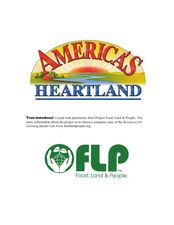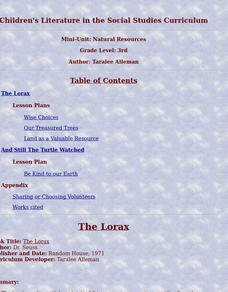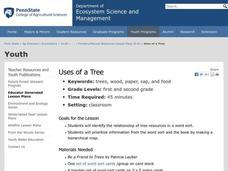Curated OER
Orange Juice - From the Tree to the Glass
Second graders work in groups to create a play showing how an orange becomes orange juice at the store. In this economics and goods production instructional activity, 2nd graders complete a webquest that guides them though discovering...
Curated OER
Tree-mendous Game
Students play a game where they classify the different characteristics of trees. In this tress lesson plan, students also use tree vocabulary and describe benefits of trees.
Curated OER
Food Preservation: Food Science, Canning, Gardening
Learners consider the procedures and safety issues involved in food preservation. They conduct experiments in canning, freezing and drying. If everyone can preserve food utilizing a variety of methods and science principles, the lesson...
Curated OER
What Do Trees Do for Dinner?
Students investigate how trees produce their own food. They examine chlorophyll cells with a microscope, analyze a cross section of a log, determine how old the tree was, simulate the distance of the roots, and create a play.
Curated OER
Wisconsin Agriculture; Berry Bunch's Cherry Fast Facts
Students explore agriculture by researching Wisconsin's economy. In this cherry industry instructional activity, students read assigned text about the amount of cherries Wisconsin produces annually and the revenue it brings in to the...
Curated OER
Agriculture in Your Life
Students examine the agricultural sources of everyday products and identify food products outside traditional farming circles. They discuss the background information, and complete activity sheets, locating various commodity locations on...
Curated OER
The Many Uses of Trees
Young scholars list all the ways humans use trees and tree by products. In this lesson students watch a video, discuss the impact trees have on humans, and research common products made from trees. The young scholars use their findings...
Curated OER
Uses of a Tree
Students complete a word sort to discover the relationship of tree resources. In this tree resource instructional activity, students examine information from the word sort and the book "Be a Friend to Trees" by Patricia Lauber. Finally,...
Curated OER
Peanut Butter Broccoli
Fifth graders explore food production by viewing DNA presentations. In this genetic engineering lesson, 5th graders discuss the foods they typically eat at home and how many common foods are engineered in a way that can produce a bigger...
Curated OER
Introduction to Trees and Wood
Students examine samples from various types of trees. In this trees and wood instructional activity, students review The Giving Tree and complete a KWL chart on trees. Students brainstorm what we get from trees and view wood samples...
Curated OER
Trees at Work... Just Look!
Students investigate the significance of trees. They collect magazine pictures of animals that live in trees, list products that are made from trees, collect twigs and create an item using the sticks, and bring in and discuss food from...
Curated OER
Exploring the Horticulture Field
The terms and definitions involved with growing, harvesting, and processing of tree fruits are given in these clear and attractive slides. Details of horticulture and crops are given. For instance, demand and growth of the industry,...
Curated OER
Food From Trees
Student use online resources to describe and compare food from trees. They take a nature walk, look for trees that give animals or people food and place foods found on a chart. In addition, they visit related sites for information.
Curated OER
Science: Food Quiz
In this science: food quiz worksheet, students answer 20 questions, not interactively, about food, then scroll down to check their answers.
Forest Foundation
The Nature of Trees
Young botanists examine the different parts of tress and then draw parallels between the functions of these parts and the function of parts of the human body.
Curated OER
Apple Kinds to Products
Students become familiar with various kinds of apples and the tree they grow on. In this Apple tree lesson, students recognize the differences between apples and can identify what happens to apples in different seasons. Students cut...
Curated OER
Food Webs
Students recognize interdependence in a food web by using yarn and notecards to create a food web and discussing what would happen if one of the organisms from a certain trophic level is removed.
Curated OER
We All Need Trees
Students complete a guessing game. In this tree products instructional activity, students view various household items and try to determine if they were made from trees. They discuss their findings and then read books about trees.
Curated OER
Discover How Trees Produce and Conserve Energy
Students discover the flow of energy from plants to humans, the importance of this and how the energy chain is effected. In this informational lesson students will see how energy is produced and conserved by trees and how it can be...
Curated OER
Land as a Valuable Resource
Students investigate why the soil is important to our lives. In this natural resources lesson, students have a farmer as a guest speaker. Students begin to understand how farmers use and protect our natural resource. Students write...
Curated OER
Uses of a Tree
Young scholars identify and explore the resources we use that come from trees. In this reading comprehension lesson, students sort word cards about resources that come from trees into groups based on the type of resource.
Curated OER
Food and Languages of the World
Third graders become familiar with the German pickle, part of the Christmas celebration in Germany. In this German pickle lesson, 3rd graders listen to the story of the German pickle and its significance to the German Christmas...
Curated OER
Agriculture in Your Life
Learners explore the origins of food and other everyday products around the United States. In this agricultural lesson, students learn basic vocabulary and practice matching common items with their agricultural source. They categorize...
Curated OER
If a tree falls in the forest.......
Young scholars identify by-products from forests used in their everyday lives. They describe several ways in which people depend on forests. Students list everyday products made from trees, then research and categorize less common...

























